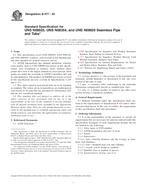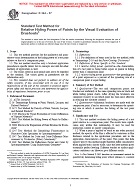1.1 This practice covers the determination of the steady-state heat flow through the meter section of a specimen when a guarded-hot-plate apparatus or thin-heater apparatus is used in the single-sided mode of operation.
1.2 This practice provides a supplemental procedure for use in conjunction with either Test Method C 177 or C 1114 for testing a single specimen. This practice is limited to only the single-sided mode of operation, and, in all other particulars, the requirements of either Test Method C 177 or C 1114 apply.
Note 1 – Test Methods C 177 and C 1114 describe the use of the guarded-hot-plate and thin-heater apparatus, respectively, for determining steady-state heat flux and thermal transmission properties of flat-slab specimens. In principle, these methods cover both the double- and single-sided mode of operation, and at present, do not distinguish between the accuracies for the two modes of operation. When appropriate, thermal transmission properties shall be calculated in accordance with Practice C 1045.
1.3 This practice requires that the cold plates of the apparatus have independent temperature controls. For the single-sided mode of operation, a (single) specimen is placed between the hot plate and the cold plate. Auxiliary thermal insulation, if needed, is placed between the hot plate and the auxiliary cold plate. The auxiliary cold plate and the hot plate are maintained at essentially the same temperature. Ideally, the heat flow from the meter plate is assumed to flow only through the specimen, so that the thermal transmission properties correspond only to the specimen.
Note 2 – The double-sided mode of operation requires similar specimens placed on either side of the hot plate. The cold plates that contact the outer surfaces of these specimens are maintained at essentially the same temperature. The electric power supplied to the meter plate is assumed to result in equal heat flow through the meter section of each specimen, so that the thermal transmission properties correspond to an average for the two specimens.
1.4 This practice does not preclude the use of a guarded-hot-plate apparatus in which the auxiliary cold plate may be either larger or smaller in lateral dimensions than either the test specimen or the cold plate.
Note 3 – Most guarded-hot-plate apparatus are designed for the double-sided mode of operation (
1.5 This practice can be used for both low- and high-temperature conditions.
1.6 This practice shall not be used when operating an apparatus in a double-sided mode of operation with a known and unknown specimen, that is, with the two cold plates at similar temperatures so that the temperature differences across the known and unknown specimens are similar.
This standard does not purport to address all of the safety concerns, if any, associated with its use. It is the responsibility of the user of this standard to establish appropriate safety and health practices and determine the applicability of regulatory limitations prior to use.
Product Details
- Published:
- 09/01/2007
- Number of Pages:
- 8
- File Size:
- 1 file , 170 KB
- Redline File Size:
- 2 files , 310 KB


